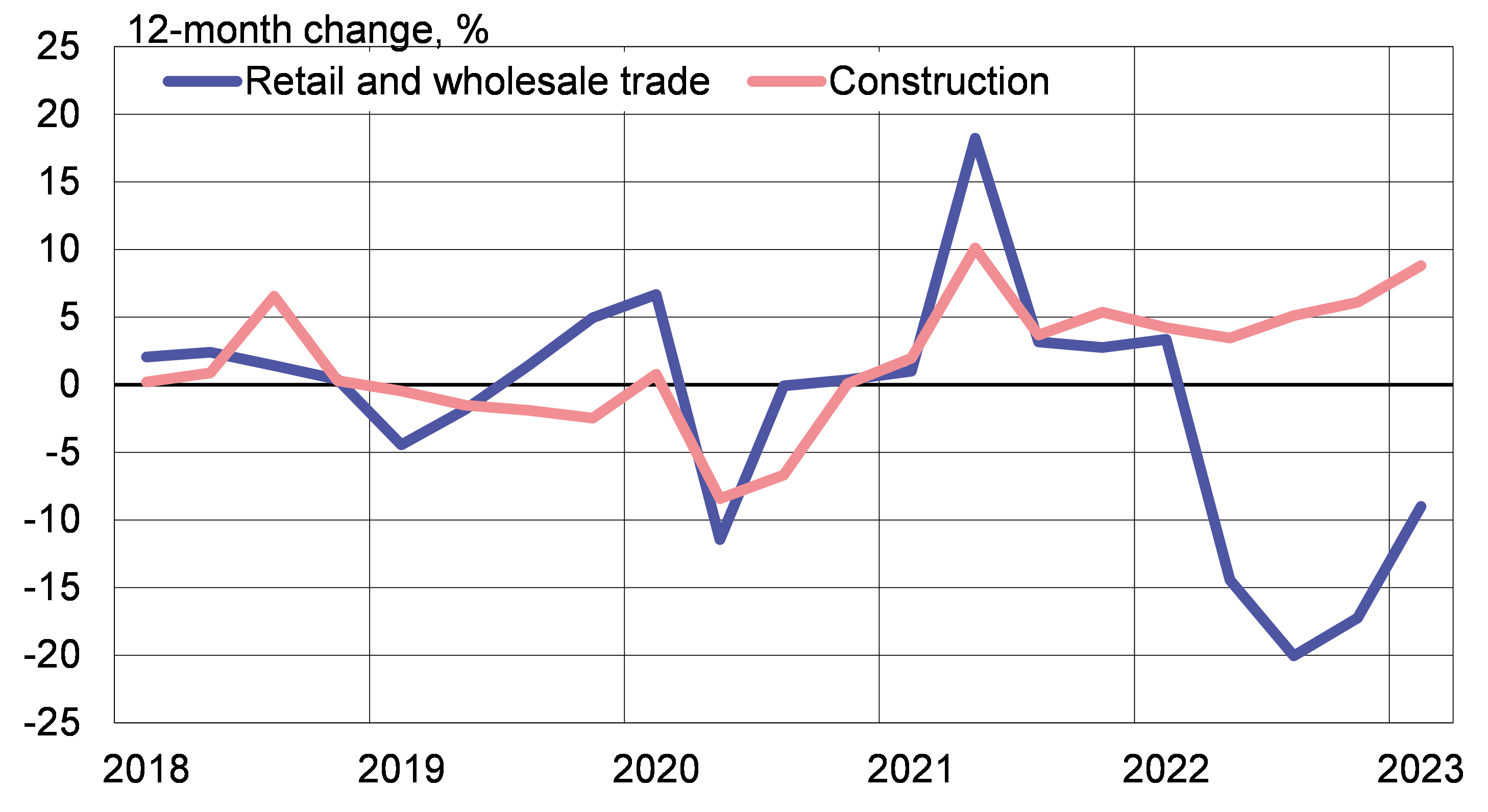BOFIT Weekly Review 21/2023
Russian first-quarter GDP contracted by 2 % on year
Rosstat’s preliminary estimate suggests that Russian GDP contracted by 2 % y-o-y during the January-March period. The rate of contraction was slowed by stabilising economic trends and the low basis reference of March 2022. Rosstat figures show that the drop in Russian GDP was sharpest in spring 2022 in the immediate wake of the Ukraine invasion, and that Russian GDP contracted by 2 % for 2022 overall. The consensus forecast from May expects GDP to contract by 0.3 % this year.
The impacts of war on the Russian economy have varied from sector to sector. Household consumption has shrunk, while fixed investment, stoked by government support, has been up. The war effort and economic stimulus caused government spending to soar.
Despite inklings of recovery, retail sales, a proxy for consumer trends, remained muted in January-March. The volume of retail sales contracted by 7 % y-o-y in the first quarter. Car sales, in particular, remained tepid. The volume of new car sales this year has been less than half the pre-invasion level.
Rosstat’s preliminary estimate suggests that Russian’s real disposable household income in the first quarter was unchanged from 1Q22. The decline in real incomes has been mitigated recently by slowing inflation and strong wage growth. Consumer prices rose by 9 % y-o-y in the first quarter. Pressures to increase wages continue due to the tight labour market. Russia’s unemployment rate hit a post-Soviet low of 3.5 % in the first quarter. Russia’s workforce was shrinking even before the war, which since caused hundreds of thousands of Russians to be sent to the front or flee the country.
Fixed investment has witnessed robust growth in recent months, fuelling construction activity and production of certain investment goods in particular. Construction increased by 9 % y-o-y in the first quarter. Growth was unaffected by a low basis reference from a year earlier as construction growth has accelerated since the February 2022 invasion of Ukraine. Construction growth was apparently driven by infrastructure projects and non-housing construction as construction of residential housing has declined.
While trade has contracted sharply since Russia’s invasion of Ukraine 15 months ago, construction has enjoyed robust growth
 Sources: Rosstat, BOFIT.
Sources: Rosstat, BOFIT.
Manufacturing output rose by 1 % y-o-y in the first quarter. Manufacturing of metal products and production of many construction goods witnessed particularly strong growth. Production declined in branches dependent on foreign trade or foreign firms. Wood processing contracted by 17 % y-o-y due to weak exports. Automobile production fell by 40 %, while machine-building was down by 12 %. A survey published by the Central Bank of Russia at the start of this year finds that firms in the automobile and pharmaceutical industries, as well as machine-building, have encountered the most problems in finding substitutes for raw materials, machinery, components and spare parts where availability has been limited by sanctions.
The 1Q23 trends for primary production were mixed. Agricultural output rose by 3 % y-o-y, while mining & quarrying production (including oil & gas) was down by 3 %. Natural gas production contracted by 14 %. Rosstat has ceased to publish figures on oil production, but the International Energy Agency (IEA) estimates that Russian crude oil production contracted by about 2 % y-o-y in the first quarter.
Production in many branches has been boosted by government spending this year. Federal budget spending in the first four months of this year was up by 22 % y-o-y, while revenues were down by roughly the same percentage. As a result, the government’s projected budget deficit for all of 2023 was eclipsed already in the first four months of this year. Russia’s approved budget framework for 2023 anticipates a federal budget deficit of 2 % of GDP – even with plans to reduce spending slightly from last year. Spending cuts will be difficult to make as long as Russia continues to make war in Ukraine.